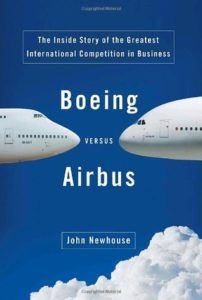Review by Andy Wagner:
Name of the Book: Boeing Versus Airbus: The Inside Story of the Greatest International Competition in Business
Author: John Newhouse
Publication Date: 2007
Book Description:
 Boeing Versus Airbus is not exactly a lean book, but it focuses on two manufacturers that are frequently at the center of discussions here at the Lean Blog, as well as those of our friends across the web at Evolving Excellence. The book by John Newhouse, a foreign policy expert, tells the story of Airbus's rise from an upstart, government-sponsored, international partnership to full competitor in the large commercial aircraft industry. That story is inevitably paralleled by Boeing's fall from holding a dominant 70% market share to today's continuing struggle for number one.
Boeing Versus Airbus is not exactly a lean book, but it focuses on two manufacturers that are frequently at the center of discussions here at the Lean Blog, as well as those of our friends across the web at Evolving Excellence. The book by John Newhouse, a foreign policy expert, tells the story of Airbus's rise from an upstart, government-sponsored, international partnership to full competitor in the large commercial aircraft industry. That story is inevitably paralleled by Boeing's fall from holding a dominant 70% market share to today's continuing struggle for number one.
Boeing dominated the large commercial aircraft industry from the introduction of the 707 in 1958 until the mid-1990s, when a perfect storm of competition, arrogance, and poor business decisions conspired against the company. The storm started with the introduction of the narrow-body A320 in 1987, when Airbus entered one of the fastest growing market segments with an aircraft 22 years newer than Boeing's 737-series. Boeing, overstrung and over-budget with its 777 project, declined to answer the challenge with a new airframe, and instead updated the 737 for the second time. This decision left them with a smaller cabin width, no fly-by-wire, and uncompetitive aerodynamics.
Making matters worse, Boeing was determined to maintain market share (ala General Motors), and began heavily discounting aircraft. Rather than putting Airbus in the grave, the discounts backfired. A traditional manufacturing philosophy had put Boeing at a 12-15% cost disadvantage versus Airbus. Despite a token lean effort started in the early 1990s, Boeing's capacity to build aircraft required twice as much floor space as Airbus for the same production volumes. To build the 777, the company added two massive bays to its Everett wide-body assembly facility… only one bay was actually used to assemble aircraft, the second was for parts storage. According to Newhouse, when Boeing CEO Phil Condit received the report on Airbus's cost advantages, he didn't shoot the messenger, but he did bury the message, rather than honoring the threat.
A personal aside, I remember starting training at my first engineering job out of college with a young former Boeing engineer. Although I didn't realize the significance at the time, he told me about Boeing's obsession with Japanese methods of having every thing in exactly the right place on your desk (5S gone “L.A.M.E.”). He said that while Boeing frequently used shims to ensure fit of parts, Airbus did not. His role at Boeing? Material Review Board: evaluating the use of nonconforming hardware. (Within 4 years, I was in a similar role at another aerospace company).
Boeing's 1997 merger with McDonnell Douglas was the last blow against Boeing in the 1990s. Despite being the surviving company, Boeing' s largest individual shareholders became James McDonnell and McDonnell Douglas CEO Harry Stonecipher. McDonnell and Stonecipher, the folks who managed their own company right out of the commercial aircraft business, were about to be in charge of the largest commercial aircraft company in the world. At the moment when Boeing most needed a strategic investment in new airframes and technology, the company fell into the hands of management that simply did not believe in commercial aviation as a business. Stonecipher and McDonnell were comfortable with the cost-plus military world and had done well there. (Later Defense contracting scandals might give us some insight into how that happened.) They did not, however, relish the notion of risking billions of the company's own dollars on a commercial aircraft that might or might not have a market and did not come with a government-guaranteed profit margin.
So how is it that 35% of the 787 was developed in Japan? Simple: Stonecipher, a graduate of the Jack Welch school of management, was unwilling to invest in a new commercial aircraft, but the Japanese government was. Others took the risks that Boeing's leadership wasn't willing to. Boeing survived the perfect storm of the 1990s and early 2000s in many ways despite itself and despite its top leadership. Although Newhouse mentions only peripherally the “Toyota-ization of Boeing”, I would argue that lean philosophy withing Boeing Commercial has played a key role in Boeing's current position in the industry.
What about Lean?
Over time, Boeing's lean manufacturing efforts have paid off for the company's bottom line. The 787 will be built in that extra bay in the Everett plant, cleared of 777 inventory. The 737 Next Generation is succeeding against the A320 using deep discounts and lean production to maintain margins, despite the age of the basic design. That said, Boeing's greatest lean success isn't on the production side, but on the product side, seeking to add value and reduce waste for their customer's customer. This is something most lean critics of Boeing have missed. While Airbus focused its efforts on the airlines' measure of success, cost per passenger mile, and built the massive A380 for hub-to-hub flights, Boeing talked to the air traveler. Air travelers don't want to be stuck in airports that are not their final destination, especially when they fly internationally. When they are spending big bucks, they want direct flights, better air quality, inviting spaces, and bigger windows. Airlines can charge more for direct flights, and with the 787's composite construction, their fuel costs are less. Boeing found a win-win by eliminating the wastes of the airline hub, the extra processing, the batching, the motion, and so forth, that every airline passenger routed through a hub endures. The airlines are buying it to the tune of 700 firm orders before the 787's first flight, an order book filled through 2012. Meanwhile the Airbus “batch and queue” A380 is only 3/5th of the way to the 250 orders needed to break even, and the word on the street is that the aircraft has been deeply discounted to get that far. Expected engineering and production delays mean that break even is further away. As I have said before, Boeing has a long way to go on its lean journey, but not as far as most of the aerospace industry. So long as they are willing to take risks and keep putting their end customer first, they can't help but succeed.
About the Book
Through interviews with key individuals in the industry, Newhouse has gathered a treasure-trove of inside information about the great competition between Boeing and Airbus. He's background in foreign policy doesn't hurt the book, but it shades it differently than a business background, an aviation background, or a knuckle-dragging manufacturing bent would. The organization of Boeing Versus Airbus is the book's weakest aspect. The first few chapters lay out the current state of the competition in a rambling way that distracts from the story. By focusing on topical chapters, rather than a pure chronology, Newhouse makes the relationships between events more difficult to understand. Some readers might have minds that work this way, but it took this reviewer some time to get used to it. Again, Boeing Versus Airbus is not a lean book per se, but as the subtitle indicates, it's about “The Greatest International Competition in Business”. We spend so much time blogging about American imports, it seems appropriate to tell the story of America's largest exporter and its worthy European competition.
(DISCLOSURE: I do not and have not ever worked for Boeing, nor does anyone in my immediate family. However, I was taught from a young age, by my Ford retiree father, that two things were sacred in this world: Ford cars and Boeing airplanes. I drive a Toyota today, for obvious reasons, but only until Alan Mulally fixes things in Dearborn.)
Please scroll down (or click) to post a comment. Connect with me on LinkedIn.
Let’s work together to build a culture of continuous improvement and psychological safety. If you're a leader looking to create lasting change—not just projects—I help organizations:
- Engage people at all levels in sustainable improvement
- Shift from fear of mistakes to learning from them
- Apply Lean thinking in practical, people-centered ways
Interested in coaching or a keynote talk? Let’s start a conversation.









![When Was the Last Time a Leader Around You Admitted They Were Wrong? [Poll]](https://www.leanblog.org/wp-content/uploads/2025/07/Lean-Blog-Post-Cover-Image-2025-07-01T212509.843-100x75.jpg)